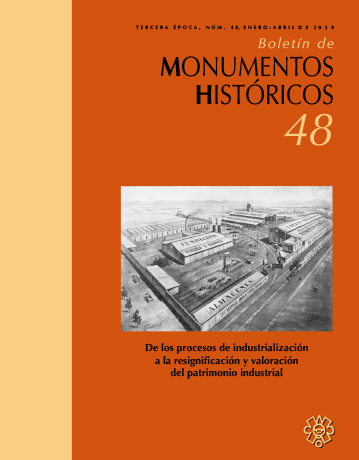La relevancia de la existencia de los sinsignos en el mobiliario industrial
Keywords:
México, Industrial furniture, Heritage, RestorationAbstract
In the Federal Law on Monuments and Archaeological, Artistic and Historical Areas, which was published in the Mexican Official Gazette on May 6, 1972, and which continues in force, there is no specificity regarding the industrial furniture of the 19th century; In addition, in official government agencies such as inah and inbal, there are no specialized departments dedicated to their conservation in an adequate manner. Furnishings are restored for their materials, but the functions of them are neglected and the most serious thing is that in most cases, due to carelessness or ignorance, the identity marks are lost (which in this article I will call them with the semiotic name of “sinsigns”). These small signs of identity are complex structured sets that can include important information of the furniture: name of the factory, country of origin, date of production, patents, distributing companies among other data. From the semiotic point of view, the sinsigns help to understand the specific singularities of a sign, which in this case would be a piece of furniture. The absence of these, causes that its analysis can only be done with its general qualities (qualisigns), which prevents its study in greater depth.
Downloads
References
Joan Costa, Identidad corporativa, reimpresión, México, Trillas (Biblioteca Internacional de Comunicación sigma), 2011, p. 31.
Haciendas de México, recuperado de: http://haciendasdemexico.org/project/hacienda-san-antonio-tochatlaco-2/
Casa de Leona Vicario, en la página de Cultura-INBA-Coordinación Nacional de Literatura, recuperada de: https://literatura.inba.gob.mx/casa-leona-vicario.html
Stuart Durant, La ornamentación. De la Revolución Industrial a nuestros días, Madrid, Alianza Editorial, 1991, pp. 85-170.
Martha Eugenia Alfaro Cuevas, “Jorge Unna Gerson, pionero del diseño industrial en México: el rescate de una empresa potosina (1889-1922)”, tesis en doctorado en historia del arte, UNAM-FFyL, México, 2010.
Página de Sargent. Assa Abloy, recuperada de: https://www.sargentlock.com/en/site/sargentlockcom/menu/aboutus/
Martha Eugenia Alfaro Cuevas, “La publicidad en la prensa ilustrada referente a las industrias mobiliarias en el porfiriato (1894-1914)”, Segundo Coloquio “Historia de la Publicidad” (ponencia), Aguascalientes, Universidad Autónoma de Aguas calientes, 2015.
Charlotte & Peter Fiell, El diseño industrial de la A la Z, Köln, Taschen, 2003, p. 166.
Charlotte & Peter Fiell, Design Handbook. Concepto, materiales, estilos, Köln, Taschen, 2006, pp. 48-49.
Isabel Campi i Valls, La idea y la materia, vol. 1: El diseño de producto en sus orígenes, Barcelona, Gustavo Gili, 2007, pp. 83-84.
DR. Graham Dry, Jacob & Josef Kohn, Bugholzöbel, catálogo de 1916, p. 1, citado en Isabel Campi i Valls, op. cit., p. 153.
John Heskett, en su libro Industrial Design, Thames and Hudson, 1980, pp. 50-67.
Sigfried Giedion, La mecanización toma el mando, Barcelona, Gustavo Gili, 1978, p. 400.
Página de Heywood-Wakefield, recuperada de: http://www.heywoodwakefield.com/about/
Página de Rose Uniacke, recuperada de: https://roseuniacke.com/designers/winfield%2C-rw
Downloads
Published
How to Cite
Issue
Section
License
Copyright (c) 2019 Instituto Nacional de Antropología e Historia

This work is licensed under a Creative Commons Attribution-NonCommercial 4.0 International License.



